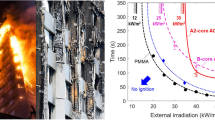Abstract
Combustible facade systems used in modern buildings envelops have received much attention in recent times due to their involvement in propagation of accidental fires in such buildings. This study presents findings from four full-scale real fire experiments performed on a three-story structure (each room being of plan dimensions \(10'\times 20'\) and story height \(10'\)) with combustible facade systems involving firestops, aluminum composite panels and glass. Two experiments simulated external fire-spread mechanism through the leap-frog effect (one with external fire source and one with internal fire source). The other two experiments were designed to study internal fire spread mechanism due to failure of firestops, a crucial design component of facade systems which is overlooked by most standardized facade fire tests. The experiments indicated that a facade fire can reach from one story to the next in about 3 min and hence, can severely limit the response and egress time for higher floors of a building. Further, the experiments showed that the facade system was exposed to heat flux levels in excess of \(100\,\mathrm{kW}/\mathrm{m}^{2}\) with maximum temperatures reaching \(1000^{\circ }\mathrm{C}\). The existing testing standards consider lower incident flux levels and the gas burners used in most existing test methods can reach maximum temperatures of around \(700^{\circ }\mathrm{C}\) only. These findings indicate a significant gap between current testing standards and real fire performance of facade systems. A study of failure mechanisms of individual components during the experiments showed the need of considering the system in its entirety rather than performing component level testing. The importance of firestops also became evident through these experiments. Properly designed firestop system ensured good compartmentation and prevented spread of fire to the upper floors, whereas improper firestop allowed fire to spread easily to upper floors. It is expected that the insights presented in this study will be useful to improve facade designs as well as to develop more robust testing procedures.


















Similar content being viewed by others
References
Andresen I, Haghighat F, Heiselberg P, Li Y, Olesen BW, Perino M, Principi P, da Silva FM, Yoshie R, Zhang J (2008) State-of-the-art review: vol. 1. State-of-the-art report: NNEX 44: integrating environmentally responsive elements in buildings, vol 1. Department of Civil Engineering, Aalborg University, Denmark. Annex 44 Website: www.civil.aau.dk/Annex44
Peng L, Ni Z, Huang X (2013) Review on the fire safety of exterior wall claddings in high-rise buildings in China. Procedia Eng 62:663–670.
Gandhi P, Jagdish V, Karthikeyan G, Chakravarthy A, Nakrani D, Ghoroi C, Srivastava G (2017) Performance of glass-ACP façade system in a full-scale real fire test in a \(\text{ G }+2\) structure. Procedia Eng 210:512–519.
The Rt Hon Sir Martin Moore-Bick (2019) Grenfell tower inquiry: phase 1 report. Technical report, United Kingdom
Nguyen KTQ, Weerasinghe P, Mendis P, Ngo T, Barnett J (2016) Performance of modern building façades in fire: a comprehensive review. Electron J Struct Eng 16:1.
White N, Delichatsios M (2015) Fire hazards of exterior wall assemblies containing combustible components. Springer, Berlin.
White N, Delichatsios M, Ahrens M, Kimball A (2013) Fire hazards of exterior wall assemblies containing combustible components. In: MATEC Web of conferences, vol 9, p 02005. EDP Sciences
White N, Delichatsios M (2014) Fire hazards of exterior wall assemblies containing combustible components. The Fire Protection Research Foundation, National Fire Protection Association (NFPA), Quincy, MA
Nishio Y, Yoshioka H, Noguchi T, Kanematsu M, Ando T, Hase Y, Hayakawa T (2016) Fire spread caused by combustible facades in Japan. Fire Technol 52(4), 1081–1106.
Bisby L (2018) Grenfell tower inquiry: phase 1 final expert report. Technical report, The University of Edinburgh, United Kingdom
Kolaitis DI, Asimakopoulou EK, Founti MA (2016) A full-scale fire test to investigate the fire behaviour of the ventilated facade system. In: Proceedings of 14th international fire and engineering conference Interflam, vol 2, pp 1127–1138
Bjegović D, Pečur IB, Milovanović B, Rukavina MJ, Bagarić M (2016) Comparative full-scale fire performance testing of ETICS systems. Gradevinar 68(05), 357–369.
Östman B, Tsantaridis L (2015) Fire scenarios for multi-storey facades with emphasis on full-scale testing of wooden facades. Fire Technol 51(6), 1495–1510.
Kotthoff I, Riemesch-Speer J (2013) Mechanism of fire spread on facades and the new technical report of EOTA “large-scale fire performance testing of external wall cladding systems”. In: MATEC Web of conferences, vol 9, p 02010. EDP Sciences
Srivastava G, Ghoroi C, Gandhi P, Jagdish V, Karthikeyan G, Chakravarthy A, Nakrani D (2018) Development of a unique full-scale real-fire façade testing facility at IIT Gandhinagar. Curr Sci 115(9):1782.
Kayacan I, Doğan ÖM (2008) Pyrolysis of low and high density polyethylene. part I: non-isothermal pyrolysis kinetics. Energy Sources Part A 30(5):385–391
Shah J, Jan MR, Mabood F, Jabeen F (2010) Catalytic pyrolysis of ldpe leads to valuable resource recovery and reduction of waste problems. Energy Convers Manag 51(12), 2791–2801.
Bystritskaya EV, Karpukhin ON, Tsverava VG, Nepovinnykh VI, Rusin MY (2011) Thermal degradation of silicone sealant. Int Polym Sci Technol 38:47–51.
National Building Code of India Part 4 Fire and Life Safety (2005) Standard, Bureau of Indian Standards, New Delhi, India
Zalok E, Eng P (2011) Validation of methodologies to determine fire load for use in structural fire protection. The Fire Protection Research Foundation, National Fire Protection Association (NFPA), Quincy, MA
EN 1991-1-2 Eurocode 1: action on structures—part 1-2: general actions–actions on structures exposed to fire. Standard, European Committee for Standardization, Brussels (2002)
Acknowledgements
The support of this work from the Centre for Safety Engineering, Indian Institute of Technology Gandhinagar and Underwriters Laboratories is gratefully acknowledged. Partial support from industry partners Shah Bhogilal Jethalal and Brothers and Hilti India Pvt. Ltd. is also acknowledged.
Author information
Authors and Affiliations
Corresponding author
Additional information
Publisher's Note
Springer Nature remains neutral with regard to jurisdictional claims in published maps and institutional affiliations.
Rights and permissions
About this article
Cite this article
Srivastava, G., Nakrani, D. & Ghoroi, C. Performance of Combustible Facade Systems with Glass, ACP and Firestops in Full-Scale, Real Fire Experiments. Fire Technol 56, 1575–1598 (2020). https://doi.org/10.1007/s10694-019-00943-4
Received:
Accepted:
Published:
Issue Date:
DOI: https://doi.org/10.1007/s10694-019-00943-4




